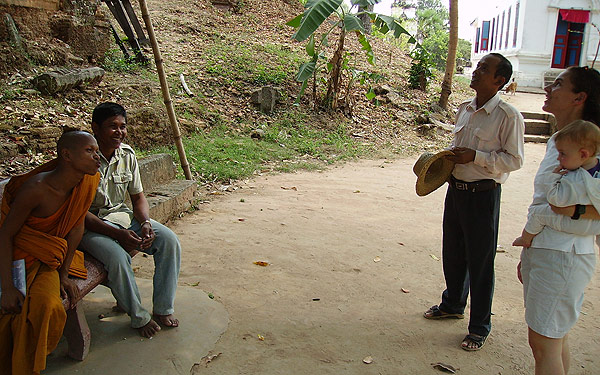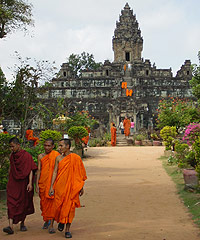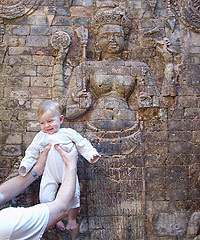
Apparently their vows include making kissy faces at American babies.
I’m sure Cambodia’s got fascinating history and stunning sites and lovely people, but man, we have a shitload of laundry to contend with. And though I love my daughter fiercely, she has pooped on 90 percent of the stuff we brought with us and we got to get the stank out. Sorry, poo trumps history. These famous temples have been here in Siem Reap for what, 900 years? They can wait another few hours. Sam, our trusty guide, got some old lady in the back of a restaurant to do all our laundry for $2—two dollars for the stinkiest stank in Southeast Asia. Anything else that happens in this country is just gravy.
In addition to his knowledge of the local laundry landscape, Sam, a middle-aged man with kind eyes, is also a historian, which means he knows every stone and every story of Siem Reap’s famous Angkor temples. “You have three days, so we will take our time,” he said. Most tourists in Siem Reap see the famous Angkor Wat, the largest religious temple in the world, and call it a day. But we were in no hurry.
|
|
Immune to the soupy heat, Sam told us stories of Vishnu and Hydra and the king of Sri Lanka stealing the queen of India through sheer trickery. He gave us lessons in mythology, Buddhism, architecture, and pedology (the study of soil), all while we touched and climbed the very stones in the legends. And sweat our pampered American asses off.
Where was Hannah during all this? Knocked out and sweat-soaked on Sarah’s back. At some point, she just sort of looked around at the ridiculous number of temples around Siem Reap, realized what she was in for, and went to sleep.
The spectre of Pol Pot’s infamous Khmer Rouge regime still hangs over the faded beauty of everything in Siem Reap, even though its brutal rule ended in 1979. “Everyone here has sad eyes,” Sarah remarked. I noticed an inordinate number of people hobbling around with no legs, and mentioned it to Sam. “Land mines,” he said. “Khmer Rouge put so many mines out there, people are still stepping on them.” Note to self: stay in car.
The pro-agrarian, anti-intellectual Communist government (motto: “To keep you is no benefit. To destroy you is no loss.”) took children from families, brainwashed them, tortured them, and killed an estimated 1.5 million people—roughly 1/5 of the population of the entire country.
Among the Khmer Rouge’s casualties: our guide’s father and brother. Sam was 16 when it happened, remembers it clearly, and he knows the two men who did it. One is a teacher in Siem Reap. When we asked Sam if he ever considered revenge, he shook off the suggestion.
|
|
“I am a Buddhist,” he said flatly. “Revenge is frowned on. If I kill the men who killed my family, someone will kill me, someone in my family will avenge my death, and it will go on. I have to stop the cycle.” He plans to interview his father’s murderer for a book he is working on.
Whatever we were paying him to be our tour guide, it wasn’t enough.
An overwhelming guilt kicked in. While the locals wilted in the heat and another member of our host nation dealt with our soiled clothes for less than the cost of a gallon of American milk, a private driver was driving us around in an air-conditioned car. Cooler full of sweaty bottled water at our feet. I began pondering questions of fate and luck and all that big-universe stuff.
ME: Why are we so lucky? [Can you pass me another cold towel, please?]
SARAH: What do you mean? [We’re almost out of water. Just six bottles left.]
ME: Why were we been born into the position of people to be catered to? Some Cambodian guy comes to Chicago, I’m not doing his laundry and driving him around. [You hungry?]
SARAH: We need to do more charity work when we get back to Chicago. [Starving.]
ME: This is really opening my eyes. [Let’s get a pizza tonight.]




